Introduction to Modulation Techniques in Computer Networks
 Laksh Sharma
Laksh SharmaWhat is Modulation?
Modulation is a fundamental concept in telecommunications that enables the transfer of data over different types of media, such as cables or airwaves. In simple terms, modulation is the process of altering certain properties of a carrier signal, like its amplitude, frequency, or phase, to encode information. This is particularly useful in computer networks, where data must travel efficiently and accurately from one device to another over various mediums.
Imagine you're speaking in a crowded room—you’d naturally change your tone or pitch to ensure you're heard and understood by someone further away. Similarly, modulation helps signals adapt so they can travel long distances without losing the information they carry, ensuring efficient data transmission.
Why Modulation is Crucial for Data Transmission
In computer networks, data is often in digital form, but not all transmission mediums (e.g., radio waves, fiber optics) are naturally suited for transmitting digital signals. This is where modulation becomes crucial, as it converts digital data into analog signals that can travel over these mediums. Without modulation, long-distance and high-speed data transmission would face significant limitations in terms of quality, reliability, and speed.
Key Reasons for Modulation in Networks:
Overcoming Distance: Modulation allows signals to reach far distances by adapting their form to the medium.
Noise Resistance: Certain modulation techniques improve resistance to noise, preserving data integrity.
Efficient Bandwidth Usage: Modulation allows multiple signals to be transmitted over a single channel simultaneously, making better use of bandwidth.
Understanding Modulation in Simple Terms
Basic Definition
Modulation is the process of altering a signal to encode information. In computer networks, modulation allows digital data to be transmitted over analog mediums like radio waves by modifying properties of a carrier wave.
Real-World Analogy
Think of modulation like changing your tone or pitch when you talk to show different meanings. For example, raising your voice emphasizes something, and whispering indicates something more private. In the same way, modulation adjusts signals to send data, so the receiver gets the intended message.
How Modulation Works
In modulation, a carrier wave—a basic signal with a steady strength, frequency, or phase—is changed to carry data. This can happen in three main ways:.
Amplitude Modulation (AM): The strength of the carrier wave is changed to show the data.
Frequency Modulation (FM): The number of times the wave moves up and down per second is changed.
Phase Modulation (PM): The position of the wave in its cycle is shifted.
By adjusting these properties, modulation lets digital data (like bits of information in a network) be sent over different media, such as cables or wireless channels, and be correctly understood by the receiver.
Early Modulation Techniques
1. Amplitude Modulation (AM)
Overview: AM was one of the first modulation techniques used, especially in analog radio and early telecommunications. In AM, the amplitude (strength) of the carrier wave changes to represent the data.
Amplitude modulation (AM) is a modulation technique used in electronic communication, most commonly for transmitting messages with a radio wave. In amplitude modulation, the amplitude (signal strength) of the wave is varied in proportion to that of the message signal, such as an audio signal
Use in Analog Systems: AM allowed for relatively simple transmission and reception but was susceptible to noise, making the signal prone to distortion from interference .

2. Frequency Modulation (FM)
Overview: FM improves upon AM by altering the frequency of the carrier wave to carry data. This variation in frequency, rather than amplitude, provides better resistance to noise.
Frequency modulation (FM) is the encoding of information in a carrier wave by varying the instantaneous frequency of the wave. The technology is used in telecommunications, radio broadcasting, signal processing, and computing.

- Benefit: FM is particularly resistant to signal degradation and interference, leading to clearer signals in environments where noise might be an issue. It became popular in early radio communications and was later adapted for some early network systems.

3. Phase Modulation (PM)
Overview: In PM, the phase of the carrier wave changes to encode information. Though PM was less common in early analog systems, it provided a foundation for more complex digital modulations used in computer networks.
Phase modulation (PM) is a modulation pattern for conditioning communication signals for transmission. It encodes a message signal as variations in the instantaneous phase of a carrier wave. Phase modulation is one of the two principal forms of angle modulation, together with frequency modulation.
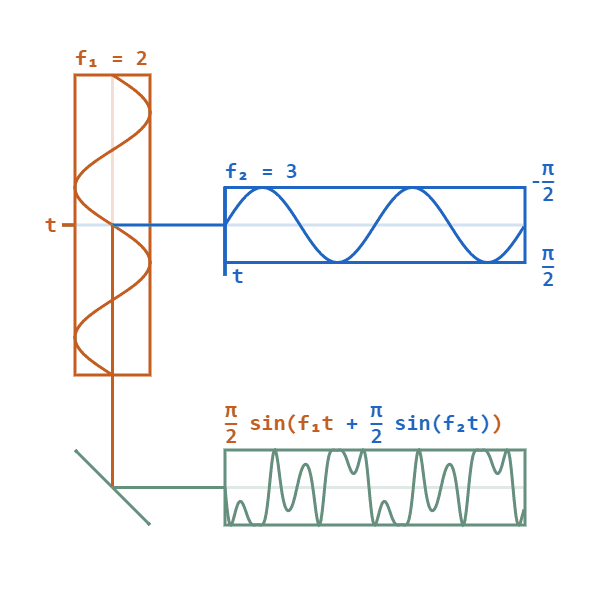
Advantage: PM is less affected by amplitude noise, and it laid the groundwork for digital phase modulation techniques, like Phase Shift Keying (PSK), widely used in data transmission today.
Advancements in Digital Modulation Techniques
As digital networks evolved, the limitations of analog modulation became apparent, particularly in terms of data speed, signal clarity, and bandwidth efficiency. Digital modulation techniques emerged as a solution, enabling faster, more reliable data transmission suitable for modern networks. Let’s delve into these advancements, including binary modulation techniques and Quadrature Amplitude Modulation (QAM).
Need for Digital Modulation
Analog modulation techniques such as AM and FM are less efficient for transmitting digital data over long distances. Analog signals are more susceptible to interference, noise, and degradation. As demand for high-speed and high-quality data transmission grew, digital modulation techniques became essential. They offer better noise immunity, increased capacity, and higher data rates, making them more suitable for digital communication networks like Ethernet, Wi-Fi, and cellular networks.
Digital modulation techniques convert digital information into an analog signal by modulating a carrier wave. Unlike analog methods that continuously vary amplitude, frequency, or phase, digital techniques operate by switching between discrete values, representing bits or groups of bits (symbols).
Binary Modulation Techniques: ASK, FSK, and PSK
Binary modulation is the simplest form of digital modulation, where two distinct states (typically 0 and 1) are used to represent the data. Common binary modulation techniques include:
Amplitude Shift Keying (ASK)
How It Works: In ASK, the amplitude of the carrier wave is changed to represent binary values. A high amplitude might represent a binary '1', while a low or zero amplitude could represent a '0'.
Applications: ASK is simple and inexpensive to implement but is highly susceptible to noise. It's used in optical communication and some basic radio system
Frequency Shift Keying (FSK)
How It Works: FSK represents binary data by altering the frequency of the carrier wave. A high frequency can signify a binary '1', while a lower frequency represents a binary '0'.
Advantages: FSK offers better noise resistance than ASK and is commonly used in radio transmission, paging systems, and low-speed data communication.
Applications: FSK is widely used in devices like modems, where it helps transmit digital signals over telephone lines
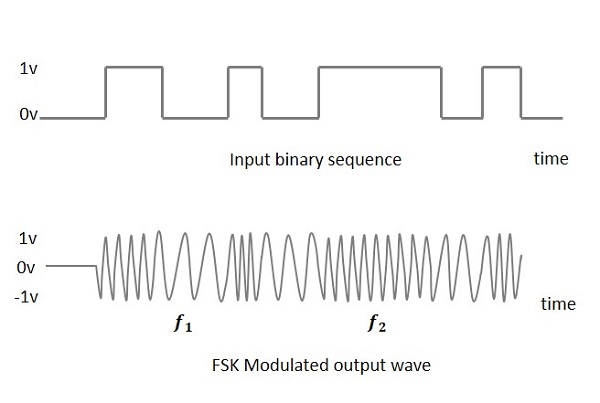
Phase Shift Keying (PSK)
How It Works: PSK changes the phase of the carrier wave to represent binary data. For instance, a 0-degree phase shift could represent '0', and a 180-degree phase shift could represent '1'.
Advantages: PSK is more noise-resistant and can be further enhanced with higher-level techniques. Variants of PSK, like BPSK (Binary PSK) and QPSK (Quadrature PSK), are widely used in digital communication for reliable data transmission.
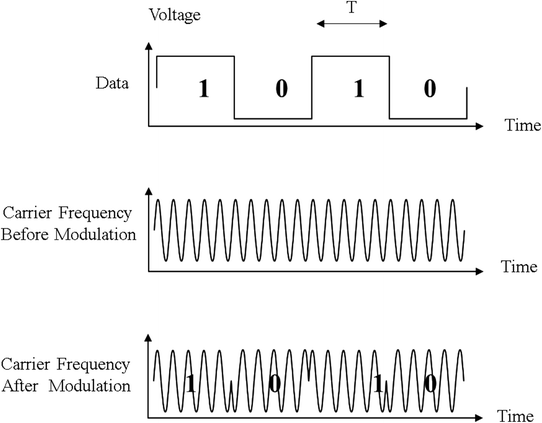
Quadrature Amplitude Modulation (QAM)
QAM is an advanced digital modulation technique that combines both Amplitude Modulation (AM) and Phase Modulation (PM). By modulating both the amplitude and phase of the carrier wave, QAM can carry more data within the same bandwidth compared to ASK, FSK, or PSK alone.
How QAM Works:
QAM transmits multiple bits per symbol by changing the amplitude and phase of the signal simultaneously. For example, a 16-QAM system transmits 4 bits per symbol, with each symbol represented by a unique combination of amplitude and phase shifts.
Higher QAM levels, like 64-QAM or 256-QAM, enable even more bits per symbol, increasing data rate. However, they require stronger signal quality and are more susceptible to noise.
Applications of QAM:
- QAM is commonly used in broadband networks, including cable modems, Wi-Fi, and 4G/5G cellular networks.
Due to its high data rate potential, QAM is ideal for systems requiring high throughput, though it requires a clean, noise-free environment to maintain accuracy at higher levels.
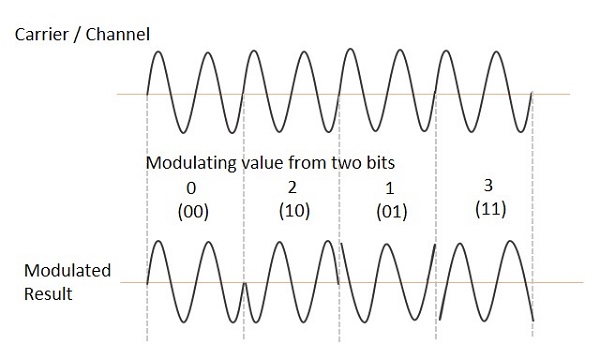
Another Example: In 16-QAM, 16 unique amplitude and phase combinations represent 4 bits of data per symbol, while in 64-QAM, 64 combinations represent 6 bits per symbol. This makes QAM suitable for applications requiring high data rates, though higher-order QAM (e.g., 256-QAM) demands better signal quality and power.
Modern Modulation Techniques in Computer Networks
As computer networks have evolved, advanced modulation techniques have been developed to support faster data rates, higher user capacities, and more reliable connections. These modern techniques, including Orthogonal Frequency-Division Multiplexing (OFDM), Code Division Multiple Access (CDMA), and Quadrature Phase Shift Keying (QPSK) and its variants, have become essential in high-speed digital communications, particularly in Wi-Fi, LTE, and 5G networks.
1. Orthogonal Frequency-Division Multiplexing (OFDM)
Overview: OFDM is a digital modulation and multiplexing method that divides a channel into multiple closely spaced sub-carrier frequencies, each carrying a part of the data. Each sub-carrier is modulated with simpler modulation schemes like QPSK or QAM.
Advantages:
High Data Rates: By splitting data across multiple sub-carriers, OFDM supports high data rates and efficient use of available bandwidth, making it ideal for Wi-Fi and LTE.
Reduced Interference and Multipath Fading: The orthogonality of sub-carriers minimizes interference among them, improving signal robustness in environments with obstacles, reflections, or interference. This is particularly useful in mobile communications where signal paths may vary due to movement.
Applications: OFDM is widely used in Wi-Fi (IEEE 802.11 standards), LTE, and even in digital television broadcasting due to its speed, efficiency, and interference resistance.
Example in Action: In Wi-Fi, OFDM enables multiple devices to connect and communicate simultaneously, ensuring that high-speed connections are maintained even in crowded environments.
2. Code Division Multiple Access (CDMA)
Overview: CDMA is a spread-spectrum technology that allows multiple users to share the same frequency band by assigning each a unique code. Each user’s data is spread over the entire frequency spectrum, using unique codes to separate users on the same channel.

Advantages:
Simultaneous Access: CDMA allows multiple users to access the network simultaneously without interference, making it highly effective for voice and data services in cellular networks.
Enhanced Security: The unique codes used in CDMA provide a level of data privacy, as only the intended receiver can decode the data using the specific code.
Resistance to Interference: By spreading the signal across a broad spectrum, CDMA is highly resistant to noise and interference, making it ideal for crowded network environments.
Applications: CDMA was widely used in 2G and 3G cellular networks (e.g., IS-95 and CDMA2000 standards) and is still utilized in some legacy networks.
3. Quadrature Phase Shift Keying (QPSK) and its Variants
Overview: QPSK is a type of phase modulation that represents data by changing the phase of the carrier wave. In QPSK, four distinct phase angles are used (0°, 90°, 180°, 270°), allowing each symbol to carry 2 bits of data. This efficiency in data encoding makes QPSK a popular choice in modern digital communication systems.
Variants:
8-PSK: Uses 8 different phase shifts, representing 3 bits per symbol. This increases data throughput but requires a higher signal-to-noise ratio to maintain accuracy.
16-QAM (Quadrature Amplitude Modulation): Combines phase and amplitude shifts, allowing even higher data rates by encoding 4 bits per symbol.
Advantages:
Higher Data Rates: By encoding multiple bits per symbol, QPSK and its variants provide higher data rates without needing more bandwidth.
Adaptability: In modern adaptive modulation systems, QPSK can switch to higher-order modulation schemes like 16-QAM or 64-QAM based on network conditions, optimizing performance.
Applications: QPSK is used in LTE, satellite communications, and Wi-Fi. The versatility of QPSK and its variants in adapting to signal quality and bandwidth availability has made it a standard in many modern communication systems.
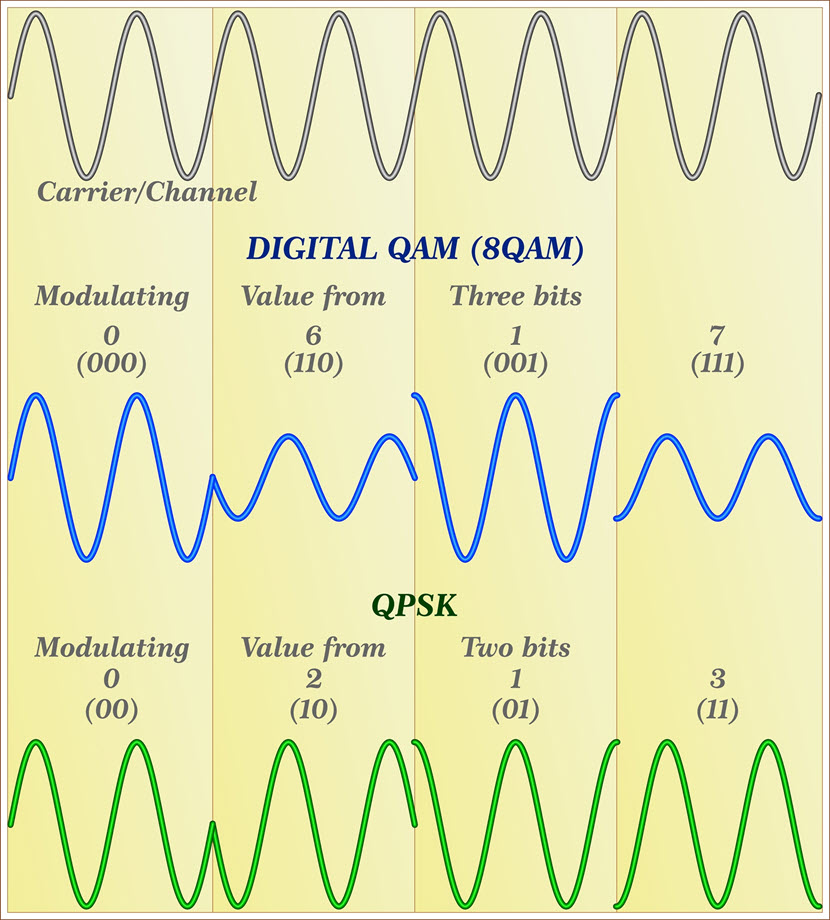
Impact on Network Performance and Efficiency
1. Data Rate and Bandwidth
Advanced modulation techniques significantly improve data rates and make more efficient use of available bandwidth, which is crucial in today’s bandwidth-intensive applications:
High Data Rates: Techniques like Quadrature Amplitude Modulation (QAM) and Orthogonal Frequency-Division Multiplexing (OFDM) support higher data rates by encoding multiple bits per symbol and using a large number of sub-carriers. For example, 256-QAM allows 8 bits per symbol, packing more data into each transmission.
Efficient Bandwidth Utilization: Techniques like OFDM split the available bandwidth into multiple, closely spaced sub-carriers. Each sub-carrier carries part of the data, which helps utilize the channel more efficiently and supports high-speed data transmission. Additionally, adaptive modulation can adjust the modulation scheme based on channel quality, maximizing data throughput without exceeding available bandwidth.
2. Noise and Interference Management
Effective noise and interference management is critical for maintaining signal clarity and data accuracy:
Resilience Against Noise: Spread-spectrum technologies like Code Division Multiple Access (CDMA) spread data across a wide frequency range, making it resistant to localized interference. Similarly, PSK (Phase Shift Keying) and its variants resist noise by using phase changes to represent data, maintaining integrity even with moderate noise.
Interference Reduction: OFDM’s orthogonal sub-carriers are specifically designed to minimize interference between signals, a feature that ensures reliable communication in dense environments like Wi-Fi networks. Also, error correction methods like forward error correction (FEC) are embedded in many advanced modulation schemes, detecting and correcting errors to improve accuracy.
3. Scalability
Scalability is essential to support the growing number of devices and users in modern networks:
Increased User Capacity: CDMA allows multiple users to occupy the same frequency band by assigning each a unique code, enabling simultaneous, interference-free connections. Similarly, OFDM divides bandwidth into multiple sub-carriers, each capable of carrying data for a separate user or device, maximizing capacity.
Adaptability in Crowded Environments: Adaptive modulation allows devices to switch between schemes like QPSK, 16-QAM, and higher orders based on network load, ensuring efficient use of resources even in crowded networks.
Support for Future Needs: Higher-order modulation techniques like 1024-QAM used in 5G anticipate high data demands, ensuring that networks are equipped to handle applications requiring intensive bandwidth, such as virtual reality, IoT, and streaming.
Challenges and Future Trends in Modulation
Challenges in Modulation
Signal Attenuation: As signals travel over long distances or through obstacles, they weaken (attenuate), leading to data loss or degraded quality. High-frequency signals, especially in 5G mmWave bands, are more susceptible to attenuation, limiting their range and requiring solutions like repeaters or small cells.
Interference: With the increasing number of devices connected to networks, managing interference has become crucial. Devices competing for the same frequency bands can interfere with each other, causing data loss or errors. Although techniques like OFDM and CDMA help manage interference, the problem intensifies in dense, urban environments.
Energy Efficiency: Advanced modulation schemes, especially those supporting high-order QAM (e.g., 1024-QAM), consume more power. Balancing high data rates with energy-efficient transmission is a critical challenge, particularly for battery-dependent devices like smartphones and IoT sensors.
Future Trends in Modulation for 5G and Beyond
- Massive MIMO (Multiple Input, Multiple Output): MIMO involves using multiple antennas at both the transmitter and receiver to create parallel channels for data. Massive MIMO, with hundreds of antennas on base stations, further boosts capacity and signal strength by creating multiple data streams. This increases data throughput and reliability, making it a fundamental technology for 5G networks.
- Millimeter-Wave (mmWave) Technologies: Operating at high frequencies (30–300 GHz), mmWave modulation provides access to large, underutilized bandwidths. These frequencies support extremely high data rates and low latency, essential for 5G applications. However, due to high attenuation and susceptibility to interference, mmWave requires advancements like beamforming to ensure signal focus and strength.

- Adaptive and Cognitive Modulation: Future networks are likely to incorporate adaptive and cognitive modulation, where devices adjust their modulation schemes in real time based on environmental factors, network conditions, and energy needs. This flexibility enhances network performance, energy efficiency, and interference management.
Comments
Theme images by enot-poloskun
Subscribe to my newsletter
Read articles from Laksh Sharma directly inside your inbox. Subscribe to the newsletter, and don't miss out.
Written by



